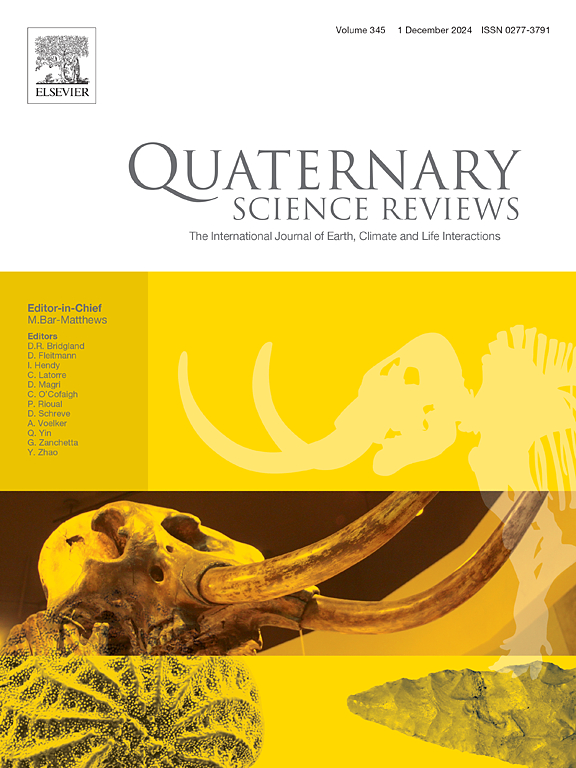Lake sedimentation and landscape evolution since ∼31 ka in Isla Grande de Chiloé, northwestern Patagonia (42°S)
IF 3.2
1区 地球科学
Q1 GEOGRAPHY, PHYSICAL
引用次数: 0
Abstract
We combine sedimentological analysis, high-resolution imaging, and X-ray fluorescence data to investigate sedimentary processes and landscape evolution from lake records in central Isla Grande de Chiloé (42°23′S, 72°49′W), northwestern Patagonia between ∼31-1.6 ka. The oldest section consists of laminated inorganic silts with a local geochemical signature deposited in a low-energy environment (Stage 1: ∼31-26 ka), interrupted by hiatuses and coarse-grained allochthonous deposits associated with high-energy events (Stage 2: ∼26-18 ka). The end of laminated facies and increasing organic matter led to a rising productivity trend and slope stability (Stages 3 and 4: ∼18-14.1 ka, ∼14.1-10.8 ka), along with volcaniclastic influx advected from the Andean Southern Volcanic Zone (Stage 5: ∼10.8 -1.6 ka). We interpret sedimentation in proglacial lakes fed by varying intensities of glacier meltwater from the western margin of the Golfo Corcovado piedmont lobe during the LGM in Patagonia, followed by a sudden change to closed-basin lakes driven by glacier withdrawal at the onset of the Last Glacial Termination (∼18 ka). This detachment shifted the facies composition and arrangements toward predominance of climate and distal volcanic processes until ∼1.6 ka. Our records capture salient millennial-scale features of the environmental evolution from western Patagonia since ∼31 ka, and match paleoclimate records at zonal and hemispheric scales. Our facies analysis underscores the presence of centennial fluctuations and instantaneous processes through glacial and non-glacial lake regimes.
巴塔哥尼亚西北部(42°S) Isla Grande de chilo约31 ka以来湖泊沉积与景观演化
我们将沉积学分析、高分辨率成像和x射线荧光数据结合起来,研究了巴塔哥尼亚西北部Grande de chilo岛中部(42°23'S, 72°49'W)湖泊记录在~ 31-1.6 ka之间的沉积过程和景观演化。最古老的部分由具有局部地球化学特征的层状无机粉砂组成,沉积于低能环境(第1阶段:~ 31-26 ka),被与高能事件(第2阶段:~ 26-18 ka)相关的断裂和粗粒异源沉积物打断。层状相的结束和有机质的增加导致了生产力的上升趋势和斜坡的稳定性(第3和第4阶段:~ 18-14.1 ka, ~ 14.1-10.8 ka),以及来自安第斯南部火山岩带的火山碎屑流(第5阶段:~ 10.8 -1.6 ka)。我们解释了在巴塔哥尼亚LGM期间,来自Golfo Corcovado山前叶西部边缘不同强度的冰川融水对前冰期湖泊的沉积作用,随后在末次冰期终止(~ 18 ka)开始时,冰川退缩导致前冰期湖泊突然转变为封闭盆地湖泊。直到~ 1.6 ka,这一拆离使相组成和排列向气候和远端火山作用为主的方向转变。我们的记录捕捉了巴塔哥尼亚西部自~ 31 ka以来环境演化的显著千年尺度特征,并在纬向和半球尺度上与古气候记录相匹配。我们的相分析强调存在百年波动和冰川和非冰川湖泊制度的瞬时过程。
本文章由计算机程序翻译,如有差异,请以英文原文为准。
求助全文
约1分钟内获得全文
求助全文
来源期刊

Quaternary Science Reviews
地学-地球科学综合
CiteScore
7.50
自引率
15.00%
发文量
388
审稿时长
3 months
期刊介绍:
Quaternary Science Reviews caters for all aspects of Quaternary science, and includes, for example, geology, geomorphology, geography, archaeology, soil science, palaeobotany, palaeontology, palaeoclimatology and the full range of applicable dating methods. The dividing line between what constitutes the review paper and one which contains new original data is not easy to establish, so QSR also publishes papers with new data especially if these perform a review function. All the Quaternary sciences are changing rapidly and subject to re-evaluation as the pace of discovery quickens; thus the diverse but comprehensive role of Quaternary Science Reviews keeps readers abreast of the wider issues relating to new developments in the field.
 求助内容:
求助内容: 应助结果提醒方式:
应助结果提醒方式:


